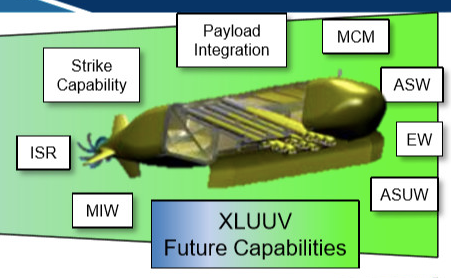Estimating XLUUV Lethality

On Sunday, March 19, 60 Minutes (CBS) aired a segment focusing on the state of the United States Navy (USN), exploring whether the USN is "in crisis," and highlighting the current rate of shipbuilding versus that of the People's Republic of China (PRC).
-
Among the Navy officials interviewed for the segment was Admiral Michael Gilday, Chief of U.S. Naval Operations. Within the context of shipbuilding, the segment mentioned the USN development of unmanned systems, briefly highlighting the Orca XLUUV program.
-
Adm. Gilday was asked specifically about the role of the Orca XLUUV, and the September, 2022, GAO report which found that the Orca program is currently $275 million over budget and three years behind schedule. From the transcript:
Norah O'Donnell: Are these, like, underwater drones?
Admiral Mike Gilday: Some of them are. Highly capable-- capable of delivering mines, and perhaps other types of weapons.
Admiral Gilday is talking about the ORCA - an extra-large unmanned undersea vehicle.
Norah O'Donnell: Can you say what it will do, or is that classified?
Admiral Mike Gilday: Well-- at a minimum, it'll have a clandestine mine laying capability. So it'd be done-- in a way that-- is very secretive-- but very effective.
Norah O'Donnell: But the GAO reports that it's already a quarter of a billion dollars over budget and three years behind schedule.
Admiral Mike Gilday: Uh, that particular platform is behind schedule. It's the first of a kind. When it delivers, I see a very high return on investment-- from that particular platform.
Norah O'Donnell: Because?
Admiral Mike Gilday: Because-- it will be among the most lethal and stealthy platforms-- in the arsenal of the U.S. military.
-
Although Adm. Gilday alluded to the platform's current mission priority - clandestine minelaying - there was no mention of the Hammerhead encapsulated torpedo mine, the anti-submarine mine that is being developed specifically for deployment by the Orca.
In the context of justifying the program's cost overruns and scheduling delays, Adm. Gilday indicated that once the Orca reaches "ICO" - initial operating capability - it will be "among the most lethal and stealthy platforms-- in the arsenal of the U.S. military."
-
Although it is possible Orca will be capable of other missions upon reaching ICO, given the urgency surrounding the situation in the Indo-Pacific, and the stated initial mission of the XLUUV, it is unlikely that the initial batch of Orcas will be capable of kinetic operations other than offensive minelaying when they join the fleet.
-
The lethality of sea mines is well established, but with only five Orcas currently on delivery, the nature and extent of Orca's lethality, as a factor of weapons loadout, is unclear. The vehicle's total mine loadout is unknown. Based on USN concept art (see below), a payload of Hammerhead encapsulated torpedo mines might number anywhere from 12 to 24 units, whereas a payload of Clandestine Delivered Mines (CDMs) would likely be greater, given its smaller dimensions. Without information concerning a payload deployment system, however, these estimates are highly speculative.
-
The Orca's relatively limited payload capacity, the operating depth of the Hammerhead and CDM, and the platform's large operational area (the first island chain), will all factor into how these platforms are deployed in order to maximize their effectiveness as clandestine minelayers. They will be able to assume greater risk in ways that larger, manned undersea platforms cannot; for example, by laying mines near heavily defended PLAN bases, along known transit routes, or in strategic chokepoints, such as the Luzon Strait.
-
The implied lethality of the Orca as a clandestine minelayer could provide a force multiplier by imposing high psychological costs on the PLAN, potentially restricting its operations.
-
As a sophisticated sensor platform, the initial fleet of five Orcas could be a force multiplier for manned platforms by providing detection, classification, and localization of both undersea and surface targets, thereby increasing their lethality.

An early USN illustration (above) of the Orca pictured the vehicle's payload bay containing twelve angled tubes, suggesting a minelaying system, or possibly torpedo tubes. A torpedo tube module would enable the platform to engage in a wide range of kinetic operations, including:
-
Anti-Submarine Warfare (ASW): Targeting manned or unmanned undersea platforms using lightweight or heavyweight torpedoes or armed AUVs.
-
Anti-Surface Warfare (ASuW): Targeting manned or unmanned surface platforms with either heavyweight torpedoes, armed AUVs, or tube-launched Harpoon anti-ship missiles.
-
Land Attack: Providing a deep strike capability via tube-launched submarine-launched cruise missiles (SLCMs), such as the Tomahawk Land Attack Missile (TLAM).
-
Anti-Seabed Warfare: In addition to gathering intelligence on seabed targets, the Orca could engage seabed targets, such as energy, communication, navigation, or weapons systems, using armed AUVs deployed from the payload bay.
The lethality of the Orca XLUUV will depend its weapons loadout, which will in turn be influenced by a range of factors, including the integration of modular payload systems that can accommodate different weapons systems, as well as the degree of human-machine teaming versus autonomy involved in vehicle operations.

